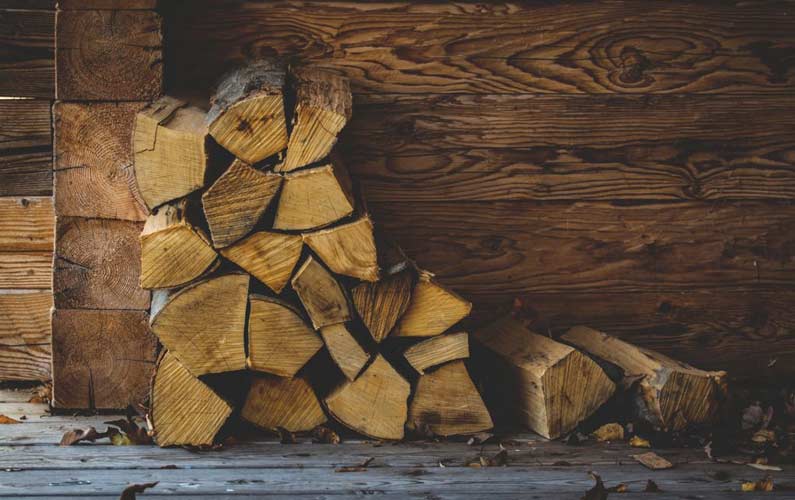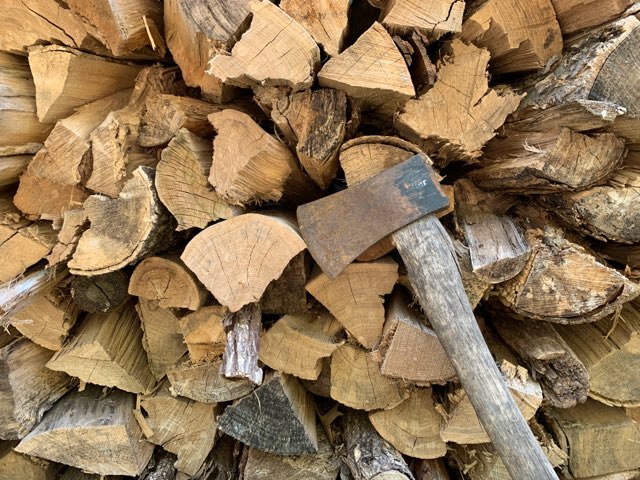What Kind of Wood is Good to Burn?
First, remember to avoid softwood. Hardwoods are generally more suitable for burning. Which woods you choose to burn in your stove or fireplace is dependent on the purpose, circumstance, and personal preference. Beyond the type of wood there are other factors to consider long before you put match to log!
Read on to determine if your wood is ready to burn and how to know if wood needs to be seasoned.
Watch the video to compare green wood versus seasoned wood.
Filmed & Produced by Robert Berry, Owner of Full Service Chimney in Kansas City
Green Wood vs. Seasoned Wood
The problem many homeowners run into is burning green or damp wood. Wet wood (more than %25 water) will be smokey and hard starting. That’s not fun!
In this video Chimney Sweep Bob adds kindling and tests two indoor fireplace fires to see which type of wood burns better. The stack of split logs on the left are green logs a.k.a. wet wood. This green wood has not yet been properly seasoned. On the right side, you’ll see a stack of logs for burning that went through the proper wood seasoning process.
Video Transcript - Green vs Seasoned Wood
How much you enjoy your wood burning fireplace or wood stove is influenced by the quality of the firewood burned inside it. Firewood that is easy to start, produces minimal creosote and odor is considered seasoned. Firewood is considered seasoned if, after it was cut down, each cut log was split, stored out of the weather and allowed to dry to a moisture content between 20-25 percent. This process takes about 6 to 12 months and occurs naturally with exposure to the sun and wind.
Here we see two similar size stacks of firewood to burn in our fireplace. The firewood on the right has seasoned for approximately 12 months. The firewood on the left is green, that is, it has had less than a month to dry. This means that, different than our seasoned wood, the green fire wood on the left has 45-50% moisture content.
Before firewood will catch fire, it must be dry enough for ignition. If it is green, the kindling has to heat the wood up and dry it out. Only then can the process of pyrolysis and charcoaling can occur, finally then the log can catch and contribute to the fire.
Hard and Soft Woods
Trees are divided into two categories, those being hard and soft. Wood cut from softwood trees will catch fire quickly and easily, but will deposit more creosote than the hardwood varieties. Logs from hardwood trees, when seasoned and prepared properly, is always the best choice for wood-burning stoves and wood-burning fireplaces.
Yet softwoods are very helpful to get a fire going. A few small pieces of pine, for example, make excellent kindling, and if used minimally, will not contribute to creosote build-up. However, if softwoods are used for more than a fire starter, then creosote builds up in the chimney. That is because softer woods are loaded with sap and resin that when burned, deposit excessive creosote.
When choosing wood for a wood stove or fireplace you must select the right hardwoods then season it properly.

Note: All wood has the same BTU potential per pound. We go in depth about this below.
There are several types of hardwoods that are good to burn in your fireplace or wood-burning stove. Hardwoods are denser, meaning they have less airspace in between the wood cells than softwoods. Therefore, there is more energy produced when burning a piece of hardwood as opposed to a piece of softwood.
Here’s our favorites…
Best Types of Wood:
- Oak
- Cherry
- Ash
- Mulberry
- Hackberry
About Manufactured Logs
Logs such as Duraflame and other “manufactured” logs found at supermarkets can be burned in a fireplace. The logs are usually made from compressed sawdust, copper sulfate, and paraffin wax. While manufactured logs burn cleaner, some fireplace users dislike the odor that the wax creates.
A few things to know:
- Never burn more than one manufactured log at a time in a fireplace.
- Poking or breaking apart a manufactured log in the fireplace will cause it to burn all at once, making a very hot fire. Be careful!
- Never burn manufactured logs in a wood-burning stove.
Types of Firewood
Do you have a wood-burning fireplace or stove? Have you ever tried to start a fire on the grate, only to have it fail to start? You’ll be glad to have easy to start fires and minimal creosote build-up because you only burned seasoned, hard wood.
First understand that all types of wood will burn, but not all wood will start a fire easily. Some kinds of fireplace wood and logs will produce more creosote than others. We can actually make our fireplace and chimney prone to flue fires by burning the wrong kind of wood! We don’t want that.
Following a few tips will ensure you burn your wood successfully and fires stay in your fireplace, not spread to your chimney.

Find the Best Fuel for Your Fireplace
Getting the best wood for burning in your fireplace or wood stove, will make your time by the hearth safer and more enjoyable. Choosing varieties that have been cut, split and stacked to season, will make starting fire’s easier, and limit the build-up of flammable creosote.
You must avoid soft, damp or green wood to burn, which will make having a fireplace or wood-burning stove warmer, safer and more enjoyable.
Hard Woods:
Hickory, Oak, and Locust all have high heat values over 24,000 BTU’s per cord. This value will improve after the wood has been split and seasoned to the ideal 20% moisture.
Soft Woods:
Spruce, Cedar, and Pine have heat values below 17,000 BTU’s per cord. The additional problem with the softwoods is the need for frequent chimney cleaning to minimize the creosote build-up when burning softwoods.
What Makes Good Firewood?
Finding good quality firewood that’s “ready to burn” is often the biggest challenge no matter where you’re located. This is why doing it yourself is often the best route. Whether you purchase logs from a supplier, a store near you, OR chop it yourself, you’ll need to keep one thing in mind:
Log Moisture Content.
Before you buy wood for fireplace fires… Remember, that a cord of wood logs was once a tree. Trees have spent years drawing water up from the ground to grow.
That same water will keep even the best wood from burning and must be dried out.
Seasoned, dried wood produces good heat output, is less smoky, and will make getting the fire going far easier. You’ll avoid a creosote causing chimney fire if you do not buy green or damp wood. You may find that seasoned wood is hard to find. Still, carefully shopping for a cord of wood with low moisture content will be worth the effort.
How to Prepare Wood for Fireplace
If you already have a good supply of cut timber, but it’s too “green” or damp to burn, consider preparing the wood yourself.
With your new woodcutting skills, you can prepare fresh wood for your fireplace or woodstove to burn all season long. To dry moisture from a freshly cut log, it must be properly prepared. This means before stacking your firewood to dry, you must first split and prepare each piece of fresh timber.
But before you start splitting logs into chunks of burnable firewood, you’ll need to learn a few tips and tricks.
Starting with How to Chop Wood properly. Learning to split your own firewood easily by hand is your first step toward a good fire burning experience with your stove or fireplace.
How to Split Logs
First, gather the following supplies and tools to start preparing your woodpile for chopping, storing, and seasoning.
Required Supplies:
First Grab a Saw and a Maul (or an axe)
Once you’ve got your supplies you’re ready to start splitting your woodpile into logs. Once you split your logs you can move on to learn how to store and prep for burning.
Safely using a wood saw and splitting maul, you can begin making each log ready to season and burn (later after it’s been properly stored).
By splitting a round log in half or fourths, the air circulation has more surface to absorb moisture from each piece.

Did You Know?
Wood is made of cellulose fibers. When looked at under a microscope tiny tubes are observed. These tubes once moved and held water while the log was a tree. By cutting and splitting our logs, we open up these tubes and allow the wood to dry out.
Splitting each log minimizes bark on most of its surface, freeing the circulating air to pull even more water out. Finally, you will notice split wood will begin to burn faster than a round log.
Axe vs. Maul
While you can use an axe to split logs, we prefer and recommend using a maul to chop wood because it’s a specialized tool that helps you achieve the best results. But if you have and prefer using an axe to split your logs, then by all means do what works best for you.
If you do not own a maul, that’s okay. As you can see in the example video while an axe is not our favorite way to chop wood it is possible and will work just fine.
No worries and Happy Chopping!
Can Firewood Be Too Dry?
Yes, logs that have a moisture content below 20% will have its own problems. Consider that wet wood won’t burn, but wood too dry will burn too fast. Wood that burns quickly also makes creosote, the fuel of chimney fires.
When checking the moisture content of logs, try knocking two sticks together and listen to the sound. Like knocking on a wall when finding a stud, the sound of damp wood is dull while seasoned wood makes a sharp sound. Fresh cut wood has a light color, while season logs will darken over time.
For more exact measurement of moisture content consider getting a wood moisture meter. A Moisture Meter will measure the amount of water in fire wood. Knowing when the wood is dried to the ideal 20-25% will give you a better idea when your wood is ready.

What is the best fireplace wood moisture content?
Experts agree 20-25% moisture content is the right balance between too wet and too dry.
Are Kiln Dried Logs Better?
Wood is often dried in what’s called a “kiln.” A kiln is essentially a humidity, temperature, and air-controlled oven designed for drying wood at an expedited rate. And not only are they dried faster than naturally seasoned logs, but they also hold significantly less moisture, meaning your fire will burn hotter and more efficiently.
Seasoned logs are fantastic because you can season them yourself; however, that takes a significant amount of time. Kiln logs are ready to burn immediately after you purchase them. With all this being said, in our opinion, kiln-dried logs are the better option.
If you have the time and patience to season them yourself, we break down how in this blog post:
Suggested Reading
If you’re interested to learn more about how to season wood properly, visit our How to Stack Wood for Seasoning post that explains it in great detail.
Conclusion
Carefully choosing or preparing the right wood to burn makes it easy to start a fire and enjoy your time spent by the hearth. Plus, you’ll avoid damaging your fireplaces flue with an unnecessary chimney fire and even make your chimney sweeps job of cleaning it a whole lot easier!
What are you waiting for? It’s time to enjoy your fireplace or wood-stove.
